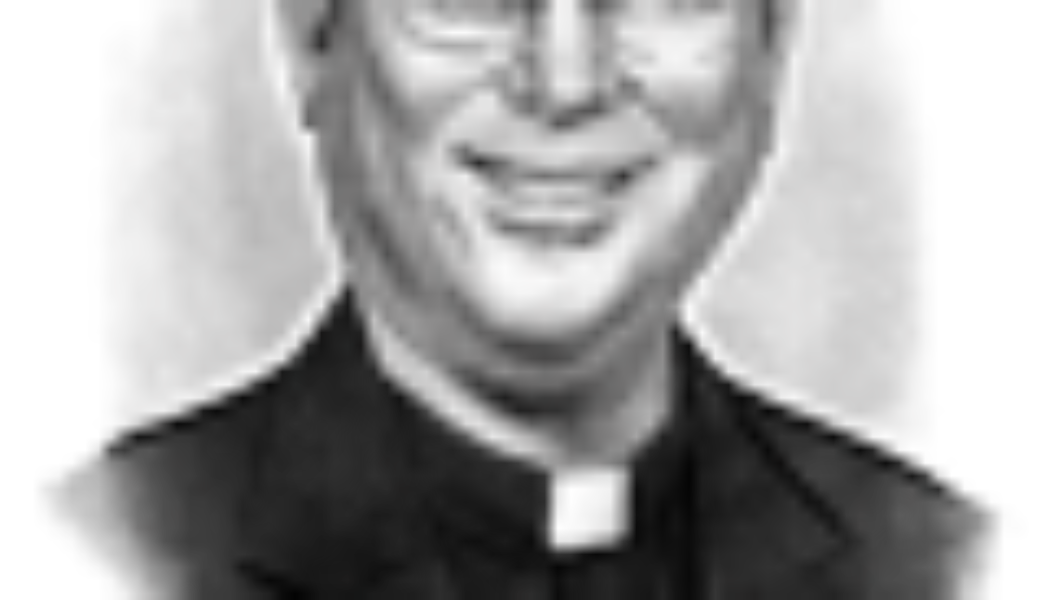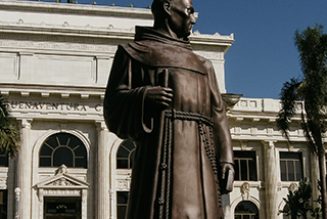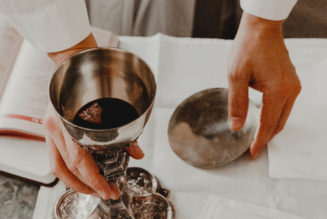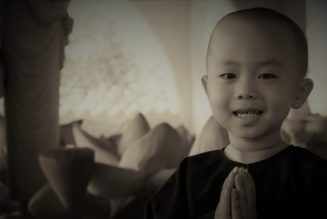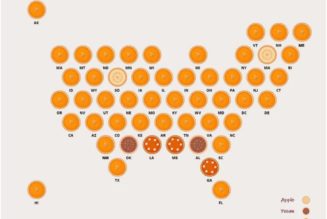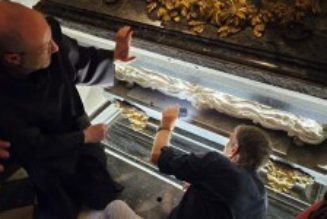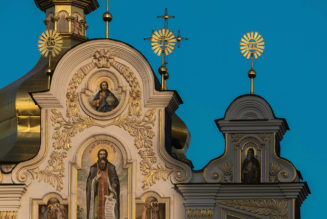By Fr. Jerry Pokorsky ( bio – articles – email ) | Feb 20, 2023
The widespread rejection of the Catholic Faith in favor of atheistic secularism makes apostasy vulnerable to an ageless counter-attack: the precepts of the Apostles’ Creed.
The Creed provokes our conscience and restores our balance as Catholics in tumultuous times. The Creed summarizes the Catholic Faith. Enhanced by “talking points,” we can use the Creed to present the entirety of Faith in less than an hour (for marriage and baptismal preparation, parental catechetical meetings, apologetics—and conversations with faithless prelates).
I believe in God, the Father almighty.
- God is without beginning and end.
- God is Three-Persons-in-One, the Blessed Trinity.
- Pentecost is the final chapter of God’s self-revelation.
Creator.
- God creates all things through His all-powerful Word, begotten not made, and in one substance with the Father.
- Creation cannot improve the infinitely perfect love of the Blessed Trinity.
- Notwithstanding, God shares His love by creating us.
- Selfless generosity is inherent to the Blessed Trinity.
Creator of heaven.
- God created heaven as the domain of the angels.
- The angels are pure spirits created with free will.
- Led by Lucifer, some angels rebel and reject God’s supremacy.
- Saint Michael the Archangel and his angels cast the rebellious angels into hell.
Creator of earth.
- God created the world as the blissful domain of man.
- God created man—male and female—in His image and likeness.
- God created man to live in Paradise according to man’s nature as embodied spirit.
- God reveals the marriage between man and woman as natural.
- God commands the first married couple to have babies: “Be fruitful and multiply, and fill the earth and subdue it; and have dominion.”
- Adam—as a male—lovingly mediates God’s love to Eve.
- Eve lovingly receives the love of God through Adam.
- God destines man in original holiness to be fully “divinized” in glory.(CCC 398)
- The tree of life sustains their bliss in Paradise.
- God presents the “tree of the knowledge of good and evil.”
- The tree is His first covenant, honoring man’s freedom.
Original Sin.
- Godly wisdom ponders the glory of creation.
- In the perfect glory of Paradise, knowledge of evil—and its contrast with good—is not wisdom. It is irrational.
- Our obsession with knowing evil displaces the worship of God.
- The serpent tempts Eve to eat the fruit; she does and persuades Adam to follow her.
- The violation of the first covenant brings self-destructive knowledge of evil and slavery to sin: shame, blame, suffering, and death.
- God enigmatically promises a redeemer to crush the head of the serpent (the devil) that tempted Eve.
- God ejects Adam and Eve from Paradise.
- After the fall, everlasting life would include unspeakable pain and horror.
- God’s withdrawal of the tree of life mercifully permits death (but only by the hand of God) to limit suffering.
- Denying access to the tree of life for those unworthy prefigures the denial of Holy Communion to manifest grave sinners.
I believe in Jesus Christ, his only Son, our Lord, who was conceived by the Holy Spirit and born of the Virgin Mary.
- Man dies and enters Sheol—the abode of the dead—awaiting God’s redeemer.
- In the fullness of time, God sends His angel to Mary—“full of grace”—the Immaculate Conception.
- Mary says “Yes” (her Fiat) to the Angel Gabriel.
- Mary’s sinless cooperation with the Holy Spirit gives birth to the Redeemer, Jesus.
- From the moment of conception when human life begins, “the Word was made flesh and dwelt among us.” (Jn. 1:14)
- In Jesus, faith and reason and science and religion are compatible.
- Indeed, science is the study of God’s handiwork.
- God and man are reconciled in Jesus, true God, and true Man.
He suffered under Pontius Pilate, was crucified, died, and was buried.
- Jesus fulfills the Scriptures, as the Gospels repeatedly reveal.
- Jesus confronts and overcomes the disobedience of sin and death, first through His miracles and teachings and then through His Passion and Cross.
- Jesus—the new Adam and the Divine Bridegroom—is the One Mediator between God and man.
- The Ten Commandments and the teachings of Jesus help us know good and reject evil, replacing the arrogance of the first Parents.
- The Sacrifice of the Cross is the outward sign of the perfect obedience of Jesus and the consequences of Adam’s evil.
- Hence, the Cross becomes the Tree of Knowledge of Good and Evil, the New and Eternal Covenant.
- We gaze upon the horror of the Cross and know evil.
- We gaze upon the Victim on the Cross and know Innocence, the perfect obedience of Jesus.
He descended into hell.
- After His death, Jesus descends into Sheol to rescue the righteous dead, extending back to Adam and Eve.
On the third day, he rose again from the dead.
- On the third day, Jesus rises from the dead in the flesh of His glorified body.
- His glorious resurrection conquers evil and overcomes its consequences of suffering and death.
- The glorious Cross is the new Tree of Life, the font of our redemption and salvation.
He ascended into heaven and is seated at the right hand of God the Father almighty.
- In His sacred humanity, Jesus, the One Mediator, ascends into heaven, brings our humanity with Him, and completes His mission of redemption. He rules forever in His glorified body in union with the Father and the Holy Spirit.
From thence, he will come to judge the living and the dead.
- Our eternal destiny is no longer of the world because, after the fall, it is under the rule of the demonic Prince of the World.
- Our eternal destiny is in heaven with God and the angels.
- We will all face a Particular Judgment when we die and a General Judgment at the end of time.
- Until death, we encounter Jesus in faith.
I believe in the Holy Spirit.
- The Holy Spirit is love personified and proceeds from the Father and the Son.
- The Holy Spirit spoke to us through the Old Testament prophets.
- After the Ascension, God sends His Holy Spirit upon us, fully incorporating us into His Mystical Body, the Church—and confirming God’s divinity as Three Persons in One God.
- We encounter the new Tree of Life in the Sacraments.
- Jesus calls us to live a Trinitarian life of selfless generosity in union with Him.
I believe in the holy catholic Church, the communion of saints, and the forgiveness of sins.
- The Church is one, holy, catholic, and apostolic.
- The Incarnation and our incorporation into the Mystical Body of Christ by Baptism elevate our nature above that of the angels.
- God incorporates us into His Church with Baptism, Confirmation, and the Eucharist.
- Through the Church, God forgives our sins in the Sacraments: Baptism, Penance, and Anointing of the Sick (Extreme Unction).
- Men and women participate in the New Covenant in the Sacrament of Matrimony.
- Priests participate in the priestly office of Jesus, the Divine Exemplar, the Bridegroom, the One Mediator between God and man, and the fatherhood of God.
- In Jesus, priests offer the Holy Sacrifice of the Mass and the Word again becomes flesh.
- The Mass participates in—and re-presents—the one Sacrifice of Calvary.
- Holy Communion is the Body, Blood, Soul, and Divinity of Jesus under the appearance of bread and wine.
- We receive Jesus—the Incarnate Word—in the Real Presence of the Eucharist, the glorified body of Jesus.
- We respond with Christian service and selfless love rooted in the perfect generosity of the Blessed Trinity, now definitively revealed.
- The authentic teachings of the Church help us understand mortal (deadly) sins and venial (not deadly) sins.
- Mortal sins rob a soul of sanctifying grace and risk damnation.
- Repentance—inflamed and ratified by the Sacraments—restores the life of Jesus in our souls.
I believe in the resurrection of the body.
- Our salvation—exalted in Jesus with glorified bodies upon the resurrection of the dead—brings eternal happiness that exceeds the bliss of the angels.
- Those of the new creation who refuse the graces of the Tree of Life bring condemnation upon themselves.
- The pains of hell—with glorified bodies—may exceed the torment of the fallen angels.
I believe in life everlasting.
- God’s revelation of His saving truths concludes with the death of the last Apostle.
- Scriptures, Apostolic Tradition (including Holy Orders), and the Church’s authentic Magisterium bring forth, develop, and present those truths in history.
- In retrospect, we see that sinless Mary is the mother and model of the Church, and Peter—even with his sins and faults—is the model of the Catholic hierarchy.
- At the end of time, there will be a new heaven, a new earth, and with God dwelling among his people in the communion of the angels and the saints.
Incorporated into His Mystical Body through the outpouring of the living waters of the Tree of Life and the Sacraments, we rejoice in our new creation. “O truly necessary sin of Adam, destroyed completely by the Death of Christ! O happy fault that earned so great, so glorious a Redeemer!” (Easter Vigil Exultet)
Sound Off! CatholicCulture.org supporters weigh in.
All comments are moderated. To lighten our editing burden, only current donors are allowed to Sound Off. If you are a current donor, log in to see the comment form; otherwise please support our work, and Sound Off!

There are no comments yet for this item.
